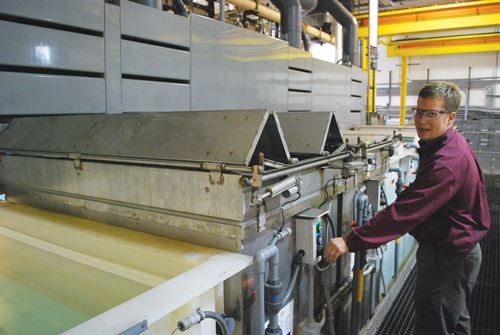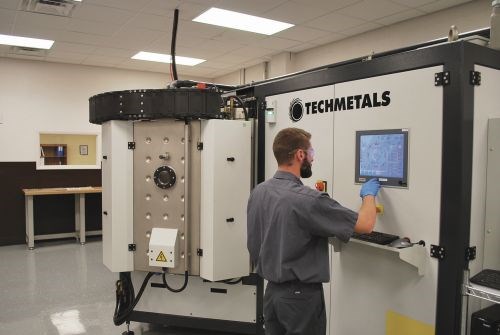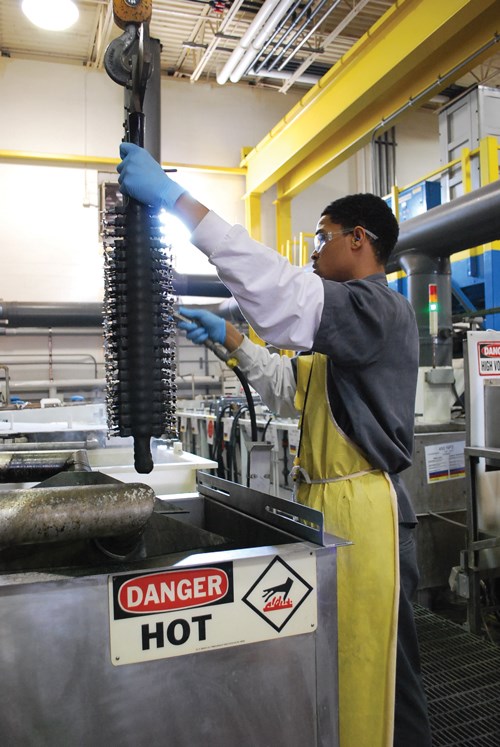Dr. Phil To The Rescue for Electroplaters
Techmetals’ president Phil Brockman is often the last electroplater that some customers visit on their search for solutions to persistent finishing issues or to plate unique parts. But it’s easy to see why most major aerospace, medical, defense, oil/gas, mold shops, and automotive manufacturers end up at Techmetals’ expansive facilities in Dayton, Ohio.
Techmetals’ president Phil Brockman is often the last electroplater that some customers visit on their search for solutions to persistent finishing issues or to plate unique parts.
“They’ve usually been around the block a few times before coming to us,” says Brockman. “We can almost always get it done for them, but it’s usually a challenge the other platers can’t fix, or don’t even want to try. That’s when they end up here.”
It’s easy to see why most major aerospace, medical, defense, oil/gas, mold shops, and automotive manufacturers end up at Techmetals’ expansive facilities in Dayton, Ohio. The campus is spread out over several large buildings, each with its own task to finish some of the most technically difficult industrial parts.
It’s a challenge that Brockman and his father, Dan, have relished for decades, along with their highly-trained staff that operate the tanks, lines and labs at the sprawling campus, which is accredited in Nadcap, AS 9100, ISO 9001, and ISO 14385, as well as ITAR, FFL, and ATF registered.
“We’ve gotten really good at solving problems that others just can’t seem to figure out,” says Bill Wheeler, who heads Techmetals’ Medical Coatings division. “It’s an acquired expertise, and we enjoy it. Who doesn’t like a challenge?”
Eight buildings
Good question. To see the high volume of workflow taking place at Techmetals, it seems a lot of manufacturers like what Brockman and his staff are doing. The laundry list of operations that spread across nearly eight separate buildings includes:
- Anodizing: aluminum, sulfuric, titanium and hardcoat, Type II and III, and more
- Electroplating: nickel, hard chrome, tin, tin-bismuth, cobalt, nickel-cobalt, copper, zinc, zinc-nickel, diamond coatings, gold, nickel phosphorus, silver, tungsten alloys, and others
- Electroless Plating: EN, low to high phosp, nickel Teflon, nickel boron, nickel boron nitride, silicar composite alloys, ceramic composite alloys, and copper
- Conversion Coatings: passivate, phosphate, chem-film, Iridite, Alodine, electropolishing, hex free options zinc nickel chromates, zinc nickel trichrome passivates, and others
- Others services: blasting, OD grinding, large vertical grinding, laser marking, etching, cleaning, repair, salvage, hard chrome replacement technologies, release coatings, optical coatings, wear coatings, anti-corrosion coatings, coloring medical grade stainless, and alloys with diamond-like particles
But the newest addition to the company’s processing line is something that will probably make Techmetals the first call for many new customers. In 2013, they started a vacuum coating operation that includes thin film cathodic arc physical vapor deposition (CAPVD), diamond like coatings (DLC), titanium carbonitride TiCN, chromium nitride CrN, aluminum titanium nitride AlTiN, aluminum titanium chromium nitride ALTiCrN, zirconium nitride ZrN, and several others, just to name a few of the 26 different TechCoat engineered coating options.
PVD sophistication
“It’s an important operation for us to add,” Brockman says. “It’s very sophisticated. Not too many platers can do this operation, but it’s what we see the market be driven to. This is a true green technology that works on many applications to replace flash hard chrome and nickel boron thallium.”
Jeff Tomczak, Techmetals’ PVD Operations Manager, was brought on toward the end of 2011 to help the company purchase and install a vacuum coating line for current and potential customers.
He says adding the line was a natural progression for Techmetals history of innovative coatings and processes.
“PVD fits very well with a lot of our existing customers who wanted an additional layer of coating on something that we’ve already plated for them,” he says. “We had customers asking about the technology, and it dovetails really well into our current operations.”
The science behind PVD technology is that it uses a targeted coating material such as titanium and combines vacuum, heat and gasses to deposit a coating onto parts. When the chamber is heated to between 212 and 1,000°F and the air evacuated, a small amount of gas is released into the area, which forms a plasma cloud that evaporates the targeted material onto the substrates of the parts.
The result is a coating that is often four times the hardness of the original substrate. Adding the coating over top a nickel or chrome coating can provide extraordinary hardness and protection.
One-Stop Shop
“The biggest advantage for us is that it gives our customers a one-stop shop to get the best coating they can get,” Tomczak says. “We knew that some of our customers were having us perform a coating operation, and then they were often sending the parts to another shop for the vacuum application. Now we can do it all for them, which is true value added.”
“If you don't have something different for your customers they have no reason to come to you,” Phil says of the latest expansion. “There may not be a coating that exists, but if you come to us with a problem, we'll create a coating for you.”
History of innovation
That has been the case since Dan started Miami Precision Chrome with partner John Stickel while the two were still in college. Stickel left the company in the mid-1970s, and Brockman brought on longtime friend Mike Frantz as a new partner as they moved what they now call Techmetals into new facilities.
Along the way, Dan and his team began patenting several finishing processes that they formulated while working on customer’s parts. Among them were Ultrakoat, an electroless nickel alloy process, and Optakoat, an electrolytic nickel plating process.
Ultrakoat is a ceramic/nickel composite coating of electroless nickel co-deposit, and has a lower coefficient of friction than Teflon, but is much harder. Techmetals eventually developed a whole family of coatings for different wear and corrosion applications for its customers, including Diamonize, a hard chrome and flame spray replacement technology that is used in many applications to handle wear, abrasion, and corrosion.
TM Invinc-alloy is also a hard chrome replacement technology and coating process designed for hydraulic rods, which the company says has three to 10 times the corrosion resistance of chrome. Armakoat is a nano-technology hard type coating with a low coefficient of friction needed in applications that have high wear. Techniloy is a hybrid EN deposit coating developed to compete with electroless nickel and other alloys. E-Krome is a uniform 56-62 Rockwell-C coating that is used mostly on high end aluminum substrate based parts that provides hardness and reduces fatigue type failures.
Growth during recession
The notion of pushing the technology envelope has been passed from Dan to Phil, who has helped oversee growth even while many shops were beset by the recent economic downturn.
Techmetals has grown from 80,000 ft2, to more than 160,000 ft2, thanks to four separate expansion projects in the last 10 years. The company now has roughly 150 employees and most areas run three shifts.
That growth has come out of Techmetals’ areas of specialty: difficult jobs, large parts, customer specifications, small medical device parts, customer-driven coating development, large vertical grinding, and heavy parts. The closest vertical grinders that can grind the parts Techmetals can are as far away as Texas.
Add to that the ability to handle parts up to 40,000 lbs, and a hook-to-floor lift height of 55 feet, and Techmetals has some of the largest plating capabilities this side of the globe.
PVD need
Adding the vacuum coating line is what Techmetals decided would work best for the company when they brought on Tomczak, who had run his own vacuum coating company for several years before deciding to join his friend Brockman at Techmetals.
When Brockman convinced Tomczak to join him, the plan of action was to order the equipment—which could take 30 weeks to build—and start working by getting space ready at the Techmetals campus.
However, when several customers heard that Techmetals was adding a vacuum coating line, they started asking about availability. Suddenly the schedule for getting the line up and running accelerated.
“The timeframe was compressed considerably, from four months to about six weeks,” says Tomczak, who knew how to get the facility ready, but still needed to figure out how to get it done at a faster pace.
It didn’t help that the room selected to house the vacuum coating line was a former maintenance facility, but within a few short weeks the room was cleaned, painted and prepped for launching the production line. Walking through the facility today, the building is spotless, with a parts cleaning line humming nearby, and a vacuum coating machine and nearby lab bustling with activities.
Cathodic arc investment
Techmetals’ equipment consists of a cathodic arc machine, meaning that it utilizes an electric arc to vaporize material from a cathode target. The material is then condensed onto a substrate, forming a thin film. Another option would be a sputter machine that dispenses a glow plasma that bombards the target to “sputter” away the material, which is then deposited on the substrate.
“Cathodic arc is a higher energy deposition,” Tomczak says. “It gives you more advantages over magnetron sputtering, or ion beam deposition.”
He says that there are only a handful of companies around the globe who make production-capable equipment, meaning those which can run 24 hours a day. Because of that, costs for the equipment are still a sizeable investment and often a barrier for entry for companies wanting to garner some of that part of the coating industry.
“Some on the market just aren’t really a good fit for high-volume production,” Tomczak says. “And of the handful, most are European. So it was important to find the right machine that was flexible for our production needs and could run multiple coatings.”
Seven vacuum coatings
The vacuum coating operation includes two technical assistants besides Tomczak, and their responsibilities mostly revolve around preparing and racking parts for the batches, which can sometimes take up to six hours to run depending on the thickness of the film desired.
That frees up Tomczak to work with Brockman on existing Techmetals customers who need to be educated on the benefits of adding vacuum coating, and to devise plans for the proper coating of those parts.
Currently, Techmetals has roughly seven basic vacuum coatings it can offer customers on a regular basis:
- DLC, Diamond Like Coating, also called Diamond Like Carbon coating: a coating with a high mechanical hardness and very low coefficient of friction; designed for the aerospace, medical, optics, molding and stamping industries,
- Titanium Nitride: a universal coating for all applications in the medical, molding and tool cutting industries,
- Titanium CarboNitride: coating with high hardness and lower coefficient of friction; used in low temperatures for the stamping, forming and cutting industry,
- Chromium Nitride: ductile coating with high release properties; used in die casting, molding and stamping,
- Aluminum Titanium Nitride: a high temperature and high hardness coating that provides increased performance in high speed machining; used in machining, stamping and sawing,
- Zirconium Nitride: coating with good lubricity; used in medical and machining.
With the new technology, Phil hopes that Techmetals will be the first stop on an OEM’s often long trail of finding a solution for its plating issues.
“We pride ourselves on getting the right solution for the customer,” he says. “We want them to brag about us. We want them to tell others what we do for them. That’s what keeps us motivated and excited about what we are doing.”
For more information on Techmetals, please call 937-253-5311, or visit Techmetals.com
Related Content
A Remarkable Rolls
Alex Innes, head of coachbuild design, Rolls-Royce Motor Cars, describes the specially commissioned La Rose Noire Droptail as “glamour distilled.” The finishes, outside and in, contribute largely to that charm.
Read MoreTop Shop’s Journey to Building a Unique Brand
Since this new Ohio plater took over the space and assets of a former plating business, it is intentional about setting itself apart from prior ownership.
Read MoreIndonesian Plater Finds Fast Success in Auto Market
This father/son team, inspired by inventor Michael Faraday, focuses on anti-corrosion methods and automated processes to help their Indonesian plating business flourish.
Read MoreEpoxy Rebar Company Reinforcing Roads of the Future
Providing epoxy-coated rebar with the ultimate corrosion resistance is Simcote’s focus for the infrastructure industry it serves.
Read MoreRead Next
A ‘Clean’ Agenda Offers Unique Presentations in Chicago
The 2024 Parts Cleaning Conference, co-located with the International Manufacturing Technology Show, includes presentations by several speakers who are new to the conference and topics that have not been covered in past editions of this event.
Read MoreDelivering Increased Benefits to Greenhouse Films
Baystar's Borstar technology is helping customers deliver better, more reliable production methods to greenhouse agriculture.
Read MoreEpisode 45: An Interview with Chandler Mancuso, MacDermid Envio Solutions
Chandler Mancuso, technical director with MacDermid Envio discusses updating your wastewater treatment system and implementing materials recycling solutions to increase efficiencies, control costs and reduce environmental impact.
Read More

























